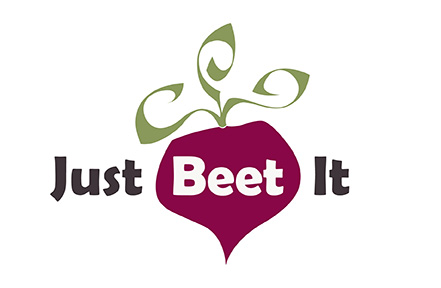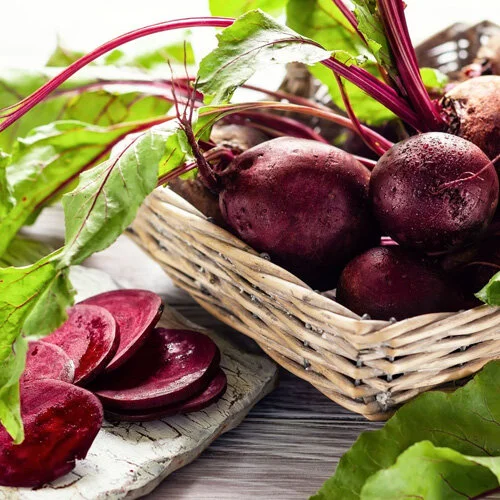Beets are completely edible from root to leaf. What? Is that crazy talk? It's not! The beet is a diverse vegetable filled with magnificent beauty and nutrition from its quirky bulbous root through its crimson "veined" stems to its luscious green locks.
Belonging to the same family as chard and spinach, the beet (and all its parts) is a remarkably nutrient-dense food packed with vitamins, minerals and antioxidants. Plus - the beetroot, stems, and leaves are all distinctly different in flavor offering diverse meal options.
The beet can be eaten raw and added to salads or smoothies, roasted with aromatic herbs and seasonings, juiced for an extra boost of energy, steamed with olive oil and sea salt, and even added to desserts! The greens and stems are also edible, and they are delightful in salads, quick-pickled for an easy side-dish, or cooked in soups.
After purchasing a gorgeous vegetable, it can be disheartening to "scrap" or throw away some of its stellar parts. It takes resources to grow every part of the amazing beet, so let's maximize all that plant energy!
Eat the beet from root to leaf. Enjoy the beet's diverse flavors. Minimize food waste. Save money, and fill your body with powerful nutrients.
BEETROOT
The beetroot is the taproot (bulb) portion of the beet plant. We are most familiar with the red beet, but there are countless varieties of beets, each with a particular flavor and nutrient profile. Beets are yellow, white, red, or pink. Some beetroots are sweeter and others more "earthy" but all offer incredible health benefits. Since ancient times, the beet has been used for dyes, teas, and medicinal properties treating constipation, fevers, skin disorders, and circulation. The magnificent beetroot is a nutritional wonder, high in antioxidants, vitamins, minerals, and fiber.
Tips for Preparing & Storing Beetroot
Roots should be washed gently before eating.
When steaming or cooking beets, keep skins intact to retain the beet’s vibrant color AND nutrients (Beet skins are a tad unsightly, but they are edible and filled with nutrients).
When storing beets, cut the beet greens and stems from the roots, so they don't pull away moisture from the root.
Leave about 1-2 inches of the stem attached to prevent the roots from "bleeding."
Place beetroots in a plastic bag and wrap the bag tightly around the beets.
Squeeze out as much of the air from the bag as possible and place in refrigerator where they will keep for up to three weeks.
How to Eat the Root
Beetroot is quite versatile and can be eaten raw in salads, steamed or roasted, baked as veggie chips, blended in smoothies, juiced, added to desserts/baked goods, or pickled. The amazing beetroot is also used for Natural Red Food Coloring and even appears in wines, beers, and cocktails. An extraordinary vegetable, the beetroot is filled with limitless possibilities in the kitchen.
Beetroot Recipe Suggestions
BEET STEMS
Beet stems are the crimson, pink, or yellow "arteries" between the beetroot and its leaves. High in fiber and minerals, beet stems also contain pigments called betalains, a powerful source of antioxidants, reducing inflammation and preventing heart disease.
Tips for Preparing & Storing Beet Stems
Separate beet stems from roots and leaves.
If preferred, keep stems and leaves intact but always separate stems and leaves from roots, so they don't pull moisture away from the root.
Store stems in a plastic bag or container in the refrigerator.
How to Eat the Stems
Saute beet stems with olive oil, lemon juice, and garlic; steam stems in soups; add raw stems to smoothies; or quick-pickle beet stems.
Beet Stems Recipe Suggestions: Quick-Pickled Beet Stems; Citrus Sauteed Beet Stems, Beet Greens and Stems Vegetable Soup
Did you know that many other vegetables and fruits can be eaten root to leaf as well? Even banana peels can be used to make delicious vegan banana peel pulled-pork sandwiches. Yum! For more root to leaf ideas, check out 24 Zero Waste Root to Stalk Recipes by the amazing Very Vegan Val.
BEET LEAVES
Comparable to the flavor and texture of chard, beet leaves are the "greens" above the beetroot and beet stems. Incredibly nutritious, beet leaves (greens) are high in minerals and vitamins, such as Calcium, Zinc, Iron, Vitamin A (beta-carotene), Vitamin C, and Vitamin K,. Although people are most familiar with eating the root (bulb) portion of the beet, historically, beet greens were consumed more than beetroots. Beet greens are healthy, tasty, and versatile.
Tips for Preparing & Storing Beet Greens
Remove beet leaves from roots and stems (if storing separately), leaving about 1-inch stem attached to root.
Store unwashed beet greens in a separate plastic bag squeezing out as much of the air as possible.
Place in refrigerator where they will keep fresh for about four days.
How to Eat the Leaves
Add raw beet greens* to salads and in smoothies, sauté greens as a side dish, or simmer greens in soups. Beet greens are also delicious when tossed with pasta or added to a scramble or omelet.
Beet Greens Recipe Suggestions: Superhero Sauteed Beet Greens; Minty Shamrock Smoothie with Beet Greens and Banana; Baked Beet Greens Chips; and Super Cleanser Beet Greens Smoothie. For more delicious ideas, check out 15 Creative Ways to Use Beet Greens.
*Individuals with existing and/or untreated kidney or gallbladder problems may wish to consult his or her physician before eating large amounts of beet greens. Like many other healthy foods, beets (notably beet greens) contain amounts of oxalates (naturally occurring substances found in plants, animals, and human beings).
References
Morgan, Diane. (2012). Roots: The Definitive Compendium with more than 225 Recipes. San Francisco, CA: Chronicle Books LLC.
Robinson, Jo. (2013). Eating on the Wild Side. New York: Little, Brown and Company.
YOU MAY ALSO LIKE

















